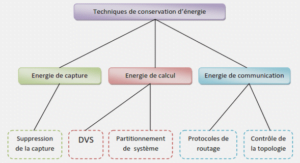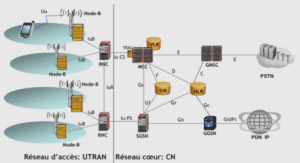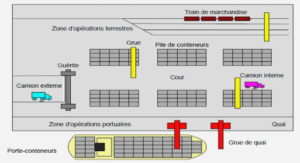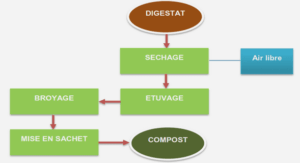The parametric wave model GENER
GENER is a parametric wave model that was developed to predict waves (R s, Ts and direction) at one deep water location using wind records from a nearby weather station (e.g. Desjardins and Ouellet, 1984). The only required inputs are a time series of lQ-m wind (velocity UIO and direction) and the computed weighted fetches for 16 directional sectors around the point of interest following the Saville (1954) method (Appendix A) recommended by OCDI (2002). The main assumptions made when using GENER is that the single wind input at each time step represents the global wind conditions over the wave generation domain and that wave generation only occurs in the direction of the wind. GENER smoothes wind directions in time using a 9 ho urs moving average to make time blocks with wind from the same sector. At time step n of a time block, a wind-fetch formula based on the effective fetch of the sector is applied to compute the largest R s and Ts obtained from aIl the possible combinations of duration and time-averaged wind velocity (step n, steps n – 1 to n, … , steps 1 to n). To take into account the previous wave conditions, a history of H s and Ts of previous time blocks is kept in memory and a linear decay of these Hs and Ts is applied between time steps, based on the time that waves of period Ts take to coyer the fetch distance in deep water. H s is then computed as a summation of wave energy (proportional to square of Hs) over present and past time blocks while Ts and wave direction are assumed to be the ones from the time block with the largest contribution to the global wave energy. The biggest advantage of GENER over recent spectral wave models is its capacity to compute wave time series over many decades at one location within a few seconds. In the original version of GENER, two wind-fetch formulas were implemented in the model, which are the methods presented in the Shore Protection Manual of 1977 (SPM77, CERC, 1977) and 1984 (SPM84, CERC, 1984). For the present study, other wind-fetch formulas were added to GENER source code to compare different parametric methods and to deterrnine the most suitable formula for the GSL. The newly implemented wind-fetch formulas are the one presented in the Coastal Engineering Manual (CEM, Resio et al., 2002), the JONSWAP method (Hasselmann et al., 1976) and the Wilson method (Wilson, 1965).
Atmospheric model wind data
The North American Regional Reanalysis (NARR, Mesinger et al., 2006) and the Modern-Era Retrospective Analysis for Research and Applications (MERRA, Rienecker et al., 2011) were chosen as two wind datasets covering the GSL for the period 1979-2012. These reanalysis datasets were respectively retrieved from NOAA National Operational Model Archive and Distribution System and from NASA Modeling and Assimilation Data and Information Services Center. NARR is a regional reanalysis with a 0.3° spatial resolution and 3-hourly UIO while MERRA is a global reanalysis with a grid resolution of 1/2° latitude x 2/3° longitude and hourly UIO . MERRA proved to be more reliable than NARR to represent wind conditions over the area, despite its lower spatial resolution which remains reasonably sufficient for wave hindcasting in the GSL with a parametric wave model (Figure 1). This could possibly be explained by its atmospheric data assimilation system GEOS-5 (Goddard Earth Observing System 5) which ai ms to improve the reanalysis accuracy (Gunturu and Schlosser, 2012) and also by its better temporal resolution. Therefore, only results obtained from MERRA wind data are presented hereinafter.
Wind preprocessing
GENER cannot directly receive a bi-dimensional wind field from an atmospheric model as input, so a new algorithm was developed to compute, at a given time, a representative wind (velocity and direction) for wave generation at one location from gridded wind data. The algorithm, described below, is applied to wind data from atmosphericmodels before executing GENER. Given a bi-dimensional wind field at a time step, not every wind vector would necessarily generate waves that would propagate toward the target location where waves must be computed. The location could also be sheltered from waves coming from certain directions. We thus require the algorithm to spatially average wind vectors influencing wave conditions at the location. To achieve tbis, 16 directions are considered. For each direction, the area where wind could potentially influence wave conditions at the location is defined as a 90° sector centered on the direction and having a radius equal to the length of the effective fetch in that direction, but without any land region. At each time step and for each direction,an « averaged wind vector » is constructed with direction from the mean wind vector and magnitude from the root mean square (RMS) of wind velocities, using aU the wind vectors within the selection area (RMS is chosen over an arithmetic average to give more weight to high wind velocities in the calculation of the « averaged wind vector »). If the angle between the « averaged wind vector » and the direction is superior to 90° (wind blowing away from the location), the wind velocity for this direction is set to O. FinaUy, from the 16 « averaged wind vectors », the one with the largest magnitude is selected as input for GENER at the given time step.
Validation wave data
GENER validation is performed by comparing its outputs with recent wave datasets obtained from Nortek CUITent profilers (AWAC-AST 600 kHz) at three locations within the lower St. Lawrence Estuary (SLE) and GSL (Figure 1). Wave parameters Hmo (equivalent to Hs), Ts and mean direction are available offshore of Saint-Ulric (AWAC-A, 48.8°N, 67.TW, 32-m depth) and Sept-Îles (AWAC-C, 50.2°N, 66.2°W, 28-m depth) from May 2010 to October 2012, and offshore of Cap d’Espoir (AWAC-B, 48.4°N, 64.3°W, 38-m depth) from October 2010 to October 2012. Although these datasets coyer the winter season, only data from April to December is used to perform GENER validation in order to avoid taking in consideration waves inftuenced by the likely presence of ice. These datasets are supplemented by wave data from buoy C45138 (Figure 1) at 49.5°N, 65.8°W (335-m depth). This buoy produced non-directional spectral wave parameters from 1991 to 2012, April to November only (downloaded from Fisheries and Oceans Canada Integrated Science Data Management website). Wave measured at this location should theoretically not be inftuenced by wave-bottom interactions. This dataset allows the validation of GENER both on short-term wave conditions or long-term wave distributions.
MERRA 1O-m wind validation and correction for the Gulf of St. Lawrence
The comparison of adjusted UIO measured at buoy C45138 with MERRA UJO output at the nearest grid point (49.YN, 66.00 W) shows that both are generally in phase but that the reanalysis globally underestimate the stronger UJO speeds (Figure 3a) while having a good agreement regarding directions (Figure 3b). The underestimation of UJO by MERRA is confirmed by the Q-Q plot (Figure 3d). By applying a correction factor of 1.30 to MERRA UJO , the agreement with the wind measurements at buoy C45138 is improved both for individual wind events comparisons (Figure 3c) and for quantiles distribution comparisons (Figure 3d). Table 1 shows that the bias, the RMSE and X2 are effectively lowered with the application of the correction factor.Validations of MERRA offshore UIO showed that the reanalysis tends to underestimate the wind velocity over the GSL (at least at both validation sites). Empirical adjustment factors had to be used to make reference wind datasets theoretically equivalent to UIO speed, but nevertheless, MERRA underestimation appears to be larger in the northwestern sector of the GSL. Given MERRA spatial resolution, this might be explained by the c10ser location of the shoreline which could potentially affect offshore wind estimation in the surface layer within MERRA. The lack of further offshore wind measurements on the GSL and the need of reanalysis offshore U IO with minimal bias for the present study constrained us to apply correction factors to MERRA UIO based on these results. Therefore, a correction factor is applied to UIO depending on the location of the grid point. A 1.30 correction factor is applied to MERRA UIO vectors west of 64.YW (northwestern part of the GSL and SLE) while a 1.15 correction factor is applied to wind data located east of 64.YW
Wave attenuation by sea ice
Sea ice influences waves mainly through scattering their energy as they propagate and by reducing open-water fetches available for wave generation by wind. Wave scattering leads to an exponential decay in space which depends on different factors including wave frequency and ice floes characteristics (concentration, size and thickness) (Squire et al., 1995; Squire,2007; Tolman, 2003). Short waves are known to experience more attenuation during their propagation through ice infested waters than long waves (Liu and Mollo-Christensen, 1988; Squire, 2007). Long waves are also reduced by an ice coyer because of the shortened fetches (Wadhams, 1983).There is no unique way to evaluate a wave climate in seasonally ice-infested waters (Tuorni et al., 2011). For example, different approaches have been followed over the years for wave climate studies in the Baltic Sea, another seasonally ice covered sea. Broman et al. (2006) have based their wave statistics directly on available wave measurements, even if wave time-series do not integrate the ice season. The same method can also be applied to wave simulations performed only for the ice-free period (as it was historically done in the GSL). Tuorni et al. (2011) have preferred to base their statistics on full year datasets by setting wave heights to zero in the presence of sea ice (ice concentration larger than 30%). Other studies, such as Soomere and Raamet (2014), simply avoided considering sea ice in their wave climate evaluation by simulating waves on an ice-free sea over full annual cycles. AlI of these methods are based on the hypothesis that waves and significant sea ice concentrations cannot coexist, which oversimplifies the reality. A more ace urate approach would model waves in ice-infested waters and wave statistics would then be evaluated from the wave time-series produced. Tolman (2003) have proposed a simple linear wave attenuation formulation, which can be integrated in spectral wave models, and which is based solely on the ice concentration, since wave decay rates are expected to increase strongly with ice concentration. Sea ice concentration is not the only parameter affecting wave attenuation by sea ice, but it is the easiest to observe and the most widely available in ice charts and ocean-ice models. More elaborated wave-ice models are in development (e.g. Wang and Shen, 2013; Williams et al., 2013a,b) and their implementation in operational wave models is ongoing (e.g. Bidlot et al., 2013). However, these new formulations generally require additional sea ice data th an only its concentration. In this study, a different approach is preferred: instead of directly implementing a waveice formulation within GENER, waves are simulated on an assumed ice-free GSL and the influence of sea ice on waves is applied to the resulting wave time series as a post-processing step.
|
Table des matières
REMERCIEMENTS
RÉSUMÉ
ABSTRACT
TABLE DES MATIÈRES
LISTE DES TABLEAUX
LISTE DES FIGURES
LISTE DES ABRÉVIATIONS
LISTE DES SYMBOLES
CHAPITRE 1 INTRODUCTION GÉNÉRALE
1.1 Contexte et problématique du projet de maîtrise
1.2 Objectifs du projet de maîtrise
1.3 Travail complété dans le cadre de la maîtrise
CHAPITRE II ÉVALUATION DU CLIMAT DE VAGUES DU GOLFE DU ST-LAURENT AVEC UN MODÈLE DE VAGUES PARAMÉTRIQUE. Il
2.1 RÉSUMÉ EN FRANÇAIS DE L’ARTICLE 1
2.2 WAVE CLlMATE EVALUATION IN THE GULF OF ST. LAWRENCE WITH A PARAMETRlC WAVE MODEL
2.2.1 Abstract.
2.2.2 Introduction
2.2.3 Methodology
2.2.3.1 The parametric wave model GENER
2.2.3.2 Using GENER with wind fields from atmospheric models
2.2.3.3 Wind preprocessing
2.2.3.4 Validation of GENER
2.2.4 Results
2.2.4.1 MERRA 10-m wind validation and correction for the Gulf of St. Lawrence
2.2.4.2 Validation of GENER used with MERRA 10 m winds
2.2.4.3 Wave climate estimation on the Gulf of St. Lawrence with GENER
2.2.5 Discussion
2.2.6 Conclusions
2.2.7 Acknowledgments
CHAPITRE III CLIMAT DE VAGUES RÉCENT ET CHANGEMENTS FUTURS ANTICIPÉS DANS LES EAUX SAISONNIÈREMENT ENGLACÉES DU GOLFE DU ST-LAURENT,CANADA
3.1 RÉsUMÉ EN FRANÇAIS DE L’ ARTICLE II
3.2 RECENT WAVE CLTMATE AND EXPECTED FUTURE CHANGES IN THE SEASONALLY ICEINFESTED WATERS OF THE GULF OF ST. LAWRENCE, CANADA
3.2.1 Abstract
3.2.2 Introduction
3.2.3 Study area
3.2.4 Methodology
3.2.4.1 Wave simulations
3.2.4.2 Wave attenuation by sea ice
3.2.4.3 Climate change assessment
3.2.5 Results
3.2.5.1 Recent-past GSL wave climate
3.2.5.2 GSL wave climate evolution with climate changes
3.2.6 Discussion
3.2.7 Conclusions
3.2.8 Acknow ledgments
CHAPITRE IV CONCLUSION GÉNÉRALE
RÉRÉRENCES BIBLIOGRAPHIQUES
ANNEXE A FORMULES DE FETCH IMPLÉMENTÉES DANS GENER
ANNEXE B PERFORMANCES DE GENER RELATIVEMENT À SWAN POUR UNE SIMULATION IDÉALISÉE
ANNEXE C CODE SOURCE MATLAB DE L’ALGORITHME DE PRÉTRAITEMENT DU VENT DÉVELOPPÉ POUR GENER
![]() Télécharger le rapport complet
Télécharger le rapport complet






